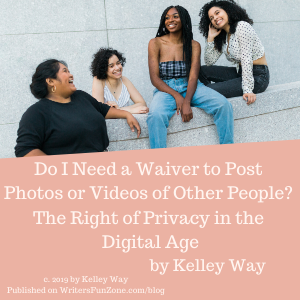Do I Need a Waiver to Post Photos or Videos of Other People? The Right of Privacy in the Digital Age by Kelley Way
 Let’s welcome back monthly columnist Kelley Way as she shares with us “Do I Need a Waiver to Post Photos or Videos of Other People? The Right of Privacy in the Digital Age.” Enjoy!
Let’s welcome back monthly columnist Kelley Way as she shares with us “Do I Need a Waiver to Post Photos or Videos of Other People? The Right of Privacy in the Digital Age.” Enjoy!
***
I was recently approached by someone who was starting a literary open mic night at her local Starbucks, to give writers an opportunity to share their works with an audience. She wanted to take pictures, and possibly video, to use in promoting the event. However, she was concerned about the logistics of getting a waiver from everyone in the audience, especially at an event like this where people are likely to come and go. Is a waiver even necessary in this situation?
The Right to Privacy vs. the Right of Publicity
Actually, it’s not. To invade someone’s right of privacy, there has to be an expectation of privacy. It would be very difficult for a person to say they had an expectation of privacy at an open event in a public location.
That person also would have a hard time claiming a right of publicity violation.
Right of privacy and right of publicity have some similarities.
The right of publicity was born from the right of privacy, and even courts often mix them up.
The key difference is that the right of privacy is essentially the right to be left alone, while the right of publicity is the right to decide when, where and how you will present yourself to the public eye.
Since this event is not for profit, and she is not using anyone’s face or identity to promote or endorse the event (I assume), there’s no real risk of a right of publicity claim here.
To Avoid an Accusation of Invasion of Privacy
Even so, there are always people who have unrealistic expectations, and they don’t need much to get a lawsuit started (besides money, but that’s an entirely different issue). To avoid the hassle and bad feelings of an accusation of invasion of privacy, there are a few things you can do:
- Give notice. If people know in advance that the event will be photographed or recorded, they can decide for themselves if they want to be on camera. If there will be a speaker or presenter, include a notification in their application or tell them directly. For the audience, put up signage that tells them that they will be photographed or recorded if they attend (or get within a certain distance, if it’s a very open space). Announcements at the beginning of the event will also work. And of course, there’s always the old fallback of prominently displaying your equipment or being very obvious about taking pictures or recording video. People can be pretty oblivious, so the more prominent and redundant your notifications are, the better.
- Get consent. This is the gold standard, which is why so many people say you have to get waivers. People might miss the large sign in front of the door, but it’s hard to explain away signing a waiver to be photographed or recorded. Speakers often expect to be photographed or recorded, but it’s still a good idea to have them sign a waiver – or at least have something on the speaker application that says that submitting the form means they consent to being photographed or recorded. Audiences are harder, which is why most people stick to notifications – or just don’t include the audience in the photo or video.
If you would like to learn more, or if you would like help drafting a notice or waiver, you’re welcome to email me at kaway@kawaylaw.com.
***
ABOUT THE AUTHOR
Kelley Way was born and raised in Walnut Creek, California. She graduated from UC Davis with a B.A. in English, followed by a Juris Doctorate. Kelley is a member of the California Bar, and an aspiring writer of young adult fantasy novels. More information at kawaylaw.com.







